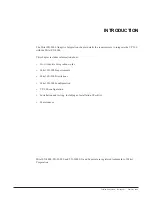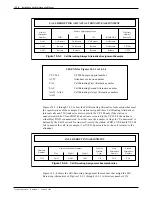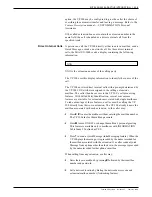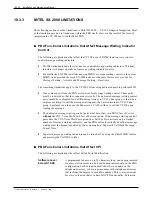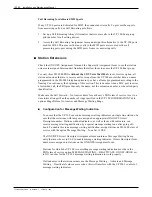
Forwarded External
When a caller at one extension calls another extension and the call is
Calls
forwarded to the VP 300, the Mitel SX-2000 sends the VP 300 a
display containing the following information:
RRR is the reason for forward (CFNA for ring-no-answer forward,
CFB for busy forward, CFFM for always forward). YYY is the
number of the extension from which the call was forwarded. If the
MIC Superset ports do not have the COS option COV Voice Mail
Port enabled, and extension YYY has an assigned name in the PBX
Telephone Directory, the assigned name will appear instead of YYY.
In this case, the extension number must be programmed as part of the
name. Refer to the Naming Conventions section in this chapter. Upon
receiving this display, the MIC uses the Superset 4’s display line
status feature to identify the source of the call. The PBX then
provides a display containing the following information:
XXX is the extension number of the calling party.
The VP 300 answers the call, tells the caller the status of the
extension called is unavailable, and offers options. If the caller leaves
a message and is calling from an extension that is a valid mailbox
number, this number is attached to the caller’s message so the VP 300
knows which caller left the message. When the person receiving the
message listens to it, the VP 300 is able to play the name of the caller
who left the message before playing the message itself. The person
receiving the message may automatically reply to it or immediately
call the sender (IntraMessaging feature).
If the called extension has a telephone directory name that does not
incorporate the extension number, the call is handled as a direct
external call from Trunk Group 0. Refer to the Called Party
Identification Call Processing section, Direct Calls from External
Trunks.
If Trunk Group 0 is configured in the TRUNK GROUP Table, the VP
300 answers with the greeting for Trunk Group 0. If Trunk Group 0 is
not configured, the VP 300 answers with the default greeting (usually
the main company greeting).
☞
In multi-cabinet VP 300 systems, the VP 300 does not play the
caller’s name to the person receiving the message, and, when
using the reply feature, the reply must be addressed.
CPI uses the Call Rerouting feature to ensure that
unanswered calls forward to the VP 300 for secondary
answering. Use of Station Call Forwarding, which
overrides Call Rerouting, may result in improper
operation of CPI.
W A R N I N G
CALLER: XXX
RRR: YYY
Toshiba VP Systems
Release 6.1
February, 1993
10.3-10
Installation and Maintenance Manual
Summary of Contents for VP 300
Page 2: ......
Page 10: ......
Page 14: ......
Page 20: ...Toshiba VP Systems Release 7 1 July 1994 ...
Page 52: ...Toshiba VP Systems Release 6 1 February 1993 2 14 Installation and Maintenance Manual ...
Page 56: ...Toshiba VP Systems Release 7 1 July 1994 ...
Page 146: ......
Page 312: ...Toshiba VP Systems Release 7 1 July 1994 ...
Page 314: ......
Page 444: ......
Page 496: ......
Page 542: ......
Page 598: ...Toshiba VP Systems Release 6 1 February 1993 ...
Page 600: ...Toshiba VP Systems Release 6 1 February 1993 ...




